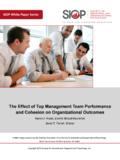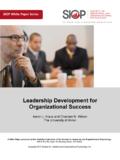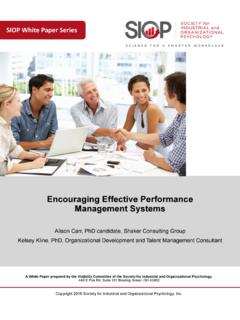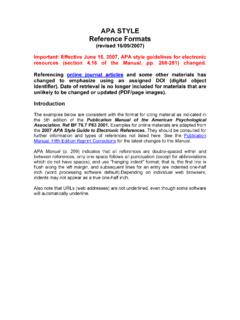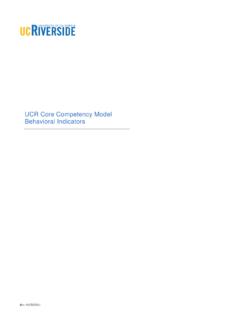Transcription of Leadership Development for Organizational Success
1 SIOP White Paper Series Leadership Development for Organizational Success Aaron J. Kraus and Chantale N. Wilson The University of Akron A White Paper prepared by the Visibility Committee of the Society for Industrial and Organizational Psychology. 440 E Poe Rd, Suite 101 Bowling Green, OH 43402. Copyright 2014 Society for Industrial and Organizational Psychology, Inc. SIOP White Paper Series Authors Chantale N. Wilson is a Research Psychologist at the Air Force Research Laborato- ry's Warfighter Readiness Research Division in the continuous learning an Perfor- mance Assessment Branch. She is also a PhD candidate in I/O Psychology at the Uni- versity of Akron. Her research interests and work include performance management, training and Development , human factors psychology, Leadership Development and cross-cultural psychology.
2 Aaron Kraus is a doctoral candidate in the Industrial Organizational Psychology pro- gram at the University of Akron and practicing Organizational Performance Consult- ant. Research includes determinants of innovation in organizations, generational dif- ferences in innovation, and innovation as it pertains to Organizational attraction. Re- cent research endeavors have investigated generational differences in attitudes and behaviors at work and predictors of early in career Success . Other research interests include Organizational engagement, social networks in selection, and training. In prac- tice, he specializes in talent analytics, recruiting, personnel selection, Leadership de- velopment, and stimulating organic growth. SIOP White Paper Series Leadership Development involves a wide range of practices acknowledged as essential for maximizing the potential of an organi- zation's human capital and growth opportunities.
3 This is reflected in the estimated 40 billion dollars spent by organizations on Leadership Development annually in the Unites States alone11, 18. To maximize the return on this significant investment, Leadership Development programs and initiatives must be designed with attention to current research and best practices. Leadership Development initiatives include formal programs and policies instituted by an organization to improve the quality of leader performance. These initiatives can be structured training programs targeted at cultivating Leadership skills, or experiential learning that presents leaders with novel challenges to overcome. Both forms are de- scribed in detail below (also see Figure 1 for a summary of the Leadership develop- ment process). When implementing a Leadership Development program, it is essential to begin by forming a Leadership competency model or a framework of relevant knowledge, skills, abilities, and other characteristics (KSAOs) particular to the organization5.
4 Not surpris- ingly, Leadership scholars emphasize the multifaceted nature of Leadership skills, which can involve cognitive, interpersonal, business, and strategic skills, each of which may be necessary at different levels of the Organizational hierarchy17. Therefore, rec- ognizing that the same KSAOs may not be relevant for all leaders across the organiza- tion and that identifying the KSAOs relevant to a particular leader at a given level is essential. This type of planning behavior acts as a catalyst for creating effective lead- ership Development initiatives, while also identifying the specific elements of a leader's identity that align with the organization's needs. Leadership Development programs should consider the formation, maintenance, and transformation of a leader's identity (how a leader views him/herself) throughout the Development process.
5 A leader's identity refers to how the individual sees him/herself as a leader and Leadership theory recognizes leaders develop and shape different identities over time. Through learning and experience, leaders can shift from a strong individual-based identity (self-directed goals) to a preferable collective-based identity (setting group/organization-level goals)6,12. A dynamic workplace requires that leaders activate various identities when communicating with different individuals or groups. A. strong Development strategy should integrate the perspectives of the leader as an indi- vidual, a member of a dyadic relationship with subordinates, and a member of the col- lective organization to understand how different identities influence a leader's psycho- logical state and behaviors12.
6 Someone in a Leadership position who identifies with that SIOP White Paper Series role will more likely seek opportunities to develop and practice Leadership skills, which can lead to consistent behaviors and role modeling for followers5,6. In addition to fulfilling Organizational demands for strong leaders, studies suggest that taking the perspective of both the leader and followers are equally necessary for effective Leadership Development . If a leader is unable or unmotivated to develop, a Development program, regardless of quality or length, will be ineffective9. In these cases coaching and preparing leaders for Development may be one solution. Further- more, it is important to consider follower expectations, reactions toward the leader throughout the Development process, and what efforts can be put in place to develop strong followership 13.
7 Follower expectations and reactions are not only indicators of a leader's Success or failure but they can also influence a leader's future develop- ment. This suggests that Leadership is not just about the leader but is shared and dis- tributed as a result of interactions between the leader and others13. Regardless of the Regardless of the method used, research shows effective Leadership Development method used, requires deliberate practice. Leadership research shows that Development can be conceptualized in an expert performance model where leaders effective Leadership develop from novices to experts as a result Development requires of intentional practice6,14. For example, leaders can practice conflict management, deliberate practice. teamwork, and communication skills by seeking out, accepting, and embracing pro- jects, assignments, and roles that provide opportunities to build the knowledge, skills, and abilities necessary to become an expert leader.
8 Other behaviors that leaders must engage in to become experts include minimizing ambiguity for themselves and subordinates by clarifying roles and expectations, clearly organizing workgroup activ- ities, communicating with members inside and outside of their immediate work team, as well as inspiring, motivating, and empowering subordinates by building strong re- lationships and leading by are all behaviors leaders should be prac- ticing by the time they enter the Leadership pipeline. Leadership pipelines allow organizations to: (1) identify high potential employees that are perceived to have Leadership ability and (2) develop them into leaders through structured training and experiential learning . Structured training programs are de- signed to improve a potential leader's skills and utilize initiatives that can be distribut- ed into four general categories: (1) individual skill Development , (2) socialization of Organizational vision and values (3) strategic Leadership initiatives to foster large- scale change, and (4) action learning initiatives targeted at addressing Organizational challenges3.
9 Organizations may use one or more of these types of initiatives (which will be described in more detail below) to develop Leadership based on what best suites their current needs and conditions. SIOP White Paper Series Implications for Practice The structured approach to developing leaders comes in various formats, which may be used independently or combined, depending on the organization's goals (see Fig- ure 1). Individual skill Development programs are characterized by the assessment of a leader's personality, values, and behaviors, oftentimes with a 360-degree feedback assessment to identify the strengths and weaknesses of a leader. Coaches are fre- quently used to deliver feedback then develop and execute an action-oriented plan to emphasize strengths and improve deficiencies4.
10 To maximize Development , coaches should deliver feedback at the task level rather than at the person level, meaning that feedback should be specific to relevant task(s) and directed at what a leader does rather than who the leader is10. Socialization programs like the assignment of mentors can orient new or newly pro- moted leaders toward the vision and values of the organization. Mentors and new leaders can be matched internally and should be selected based on job knowledge and compatibility to establish the mutual trust and respect vital to mentoring relation- ships19. A mentoring relationship can also help a leader understand the goals and op- erational style of the organization. Figure of the Leadership Development process and key considerations. SIOP White Paper Series Active strategic change strategies evaluate the internal ( , Organizational culture or change initiatives) and external ( , changes in the market or technology) condi- tions and assess the necessary Leadership to overcome challenges.
